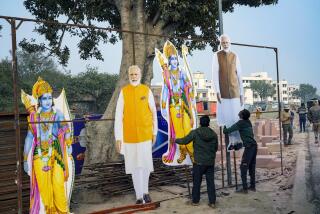Hindus to Take a Stand on Vigil Ban
- Share via
NEW DELHI — Hindu nationalists threatened Wednesday to defy a Supreme Court ban on holding a symbolic prayer ceremony near the bitterly disputed site of a mosque demolished by a mob nearly a decade ago.
The Indian government says it has deployed about 8,000 paramilitary police officers, armed with tear gas, water cannon and live ammunition, to deter any large-scale protests at the site in the northern town of Ayodhya.
But thousands of Hindu nationalists have been making their way toward the town despite efforts to stop a repeat of clashes between Hindus and Muslims that have killed more than 600 people during the last few weeks.
A three-judge panel ruled Wednesday that “no religious ceremony of any kind” may be held on a 67-acre site that includes land where the 16th century mosque, Babri Masjid, stood until a rampaging Hindu mob destroyed it in December 1992.
A lower court has yet to decide what will become of the land, but the nationalist Vishwa Hindu Parishad, or VHP, insisted again Wednesday that it is determined to build a temple on what it says is the birthplace of Lord Rama, an incarnation of the Hindu god Vishnu.
Hindu religious leaders will decide today whether to defy the Supreme Court ruling and proceed with the planned prayer ceremony Friday, the nationalist party’s secretary-general, Praveen Bhai Togadia, told reporters here.
Although he said the party accepted the Supreme Court order “with regret,” Togadia also called for peaceful protests across India to insist on Hindus’ right to pray on land next to the site of the destroyed mosque.
“There’s only one way left,” he said. “We’ll go to the ‘people’s court.’ We’ll present our case there.”
On Tuesday, VHP President Ashok Singhal had said that his followers would only protest peacefully, and invite police to arrest them, if the court refused to allow the Hindu prayer ceremony, called a puja.
But leaders of the movement to build the Ram temple have contradicted one another several times recently as they campaigned to hold prayers at the Ayodhya site. As their own allies press them to back down, the militants may decide that retreat is the better part of valor.
The party didn’t help its cause by calling Indian Prime Minister Atal Behari Vajpayee, who is a member of a Hindu nationalist party but is considered a moderate, “a new Muslim” this month.
Vajpayee and several of his key ministers have supported the Ram temple movement, but the prime minister has also repeatedly said that his government would let the courts settle the argument.
Before the court decision, Vajpayee had persuaded VHP leaders to tone down their prayer plans with the help of the National Volunteer Corps extremist group, which was implicated in the assassination of Mahatma Gandhi in 1948.
Muslim leaders rejected the proposed prayer ceremony even though it was to be held on government-controlled land next to the original site of the Babri mosque. The government also gave assurances that the ceremony would not imply ownership rights for anyone involved or affect the status quo.
But Muslims have long accused Vajpayee and his government of favoring Hindus on the potentially explosive Ayodhya issue. Vajpayee’s home affairs minister, Lal Krishna Advani, was one of several officials from the ruling Bharatiya Janata Party accused of inciting the mob that razed the Babri mosque, a charge that the officials strongly deny. The destruction of the mosque sparked sectarian riots that left between 2,000 and 3,000 dead.
Opposition Congress Party leader Sonia Gandhi joined Muslim leaders and other political figures in praising the court’s decision as a victory for the rule of law.
Gandhi’s party said Wednesday that it plans to send top officials to Ayodhya to monitor the current confrontation.
Hindus claim that a Ram temple was destroyed to make way for the mosque, which was built in 1528. But many Muslims believe that the Ram temple was a myth spread by India’s British colonial rulers as part of their “divide and rule” policy on the subcontinent.
Hindu nationalists have been gathering at a spot about two miles from the disputed site since Feb. 24 and plan to stay there until June 2, and the VHP’s Togadia angrily denied that they were defying the government by doing so.
“Can’t we exercise our religious rights in India anywhere?” he asked at a news conference.
The number of Hindu pilgrims in Ayodhya peaked at about 14,000, according to the government, but strict security measures have cut that number to a few thousand at most.
They are heavily outnumbered by well-armed police.
The most recent violence between Hindus and Muslims erupted Feb. 27 when a Muslim mob set fire to a train carrying supporters of the Ram temple movement. The inferno killed 58 people, including 14 children.
Hindu mobs retaliated across western Gujarat state by burning several hundred Muslims alive and looting and torching their shops. Human rights activists, Muslim leaders and opposition politicians have accused the VHP of organizing the revenge attacks, with police and state government complicity.
More to Read
Sign up for Essential California
The most important California stories and recommendations in your inbox every morning.
You may occasionally receive promotional content from the Los Angeles Times.










